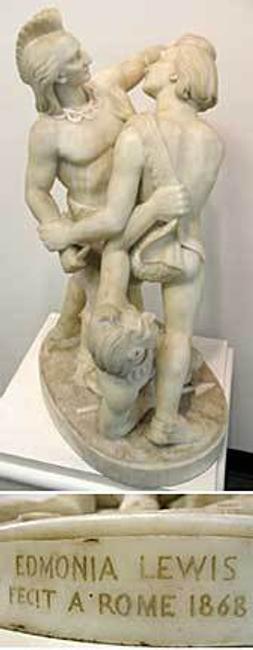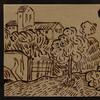New Discovery: Three Indians in Battle by Edmonia Lewis
- December 30, 2010 12:55

Written by Marilyn Richardson.
Gabriel's Auctioneers in Norwood, Massachusetts, was surprised that almost as soon as illustrated ads for its November 29, 2010, auction appeared online and in print, the phone started ringing. An unusual number of callers had questions about a particular lot. Among the ad illustrations was a series of pictures of a dramatic piece of sculpture from an Ashland, Massachusetts, estate. The owner had little information about it, other than the possibility that his father had purchased it from an unknown source sometime in the 1950's.
The 30" high marble group shows three American Indian men engaged in combat. One figure grabs another by the hair with one hand and wields a knife with his other. A third man has fallen and struggles to pull himself up or to pull one of the other warriors to the ground. A long arrow and a battle-ax lie on the ground. The dynamic and complex composition leads a viewer to circle slowly to sort out the tangle of limbs and loincloths. The sculpture, in need of cleaning and polishing, is signed and dated "Edmonia Lewis/ Fecit A Rome 1868." It is not given a title.
Lewis, born around 1842 (her birth and death dates are unknown) in upstate New York, was the daughter of a woman of part African-American, part Ojibway descent and a free Black man from the West Indies. Following study at New York Central College in McGrawville and a tumultuous stretch as a student at Oberlin College, Lewis moved in the early 1860's to Boston where she studied with Edward Brackett and set up shop in the Studio Building on Tremont Street. Her marble bust of the martyred Colonel Robert Gould Shaw established her early reputation and earned her the money and patronage to sail to Europe.
After some months spent traveling in England and on the Continent, Lewis arrived in Rome in 1866. She settled there, working at first in a studio once occupied by the great Neoclassicist Antonio Canova (1757-1822). Throughout the years she made numerous trips back to the United States to exhibit and sell her work and to arrange commissions.
A friend of Anne Whitney, Harriet Hosmer, and Charlotte Cushman, Lewis was a member of a group of expatriate British and American women artists in Italy, dubbed by Henry James "the white, marmorean flock." About Lewis he wrote: "one of the sisterhood...was a negress, whose colour, picturesquely contrasting with that of her plastic material, was the pleading agent of her fame."
James's comment notwithstanding, Lewis's work was much in demand. Her studio, listed with those of other artists in the best guidebooks, was a fashionable stop for Americans on the Grand Tour, many of whom ordered busts of literary or historical figures to adorn their mantels or front parlors. Her figures based on Henry Wadsworth Longfellow's 1855 epic poem The Song of Hiawatha were particular favorites, coming as they did from the hand of a woman known to be part Native American.
A number of Lewis's depictions from Longfellow, including groups and single busts of Hiawatha and Minnehaha, have appeared at auction in recent decades, many of them fetching substantial prices. Those works emphasize the romance of the doomed couple, showing their courtship and their marriage. None among those works is of the warlike nature of this group—hence the unexpected flood of inquiries.
Although the theme is atypical of Lewis's American Indian groups, there is an interesting contemporary reference to what could be this sculpture. In his self-published 1882 memoir, Glimpses of Europe in 1851 and 1867-8, Pennsylvania businessman Alfred Huidekoper describes an early 1868 visit to Lewis's studio where he observed "...several renderings of Indian subjects, 'Hiawatha's Wooing and Wedding,' 'Indians Wrestling,' etc." While the stripped-down figures and the muscular grappling certainly borrow from Greek and Roman wrestling scenes, the addition of the third figure and the weaponry take this encounter from competition to combat.
Competition for the sculpture itself was definitely spirited, and the room erupted into applause when a phone bidder prevailed with a bid of $287,500 (including buyer's premium). The underbidder was Michael Grogan of Grogan & Company in Dedham, Massachusetts.
Photos courtesy Gabriel's Auctioneers, Norwood, Massachusetts.
Originally published in the January 2011 issue of Maine Antique Digest. (c) 2010 Maine Antique Digest



















